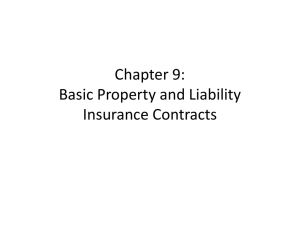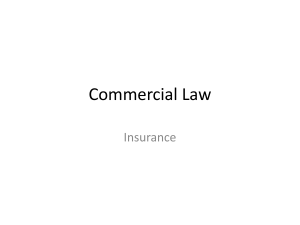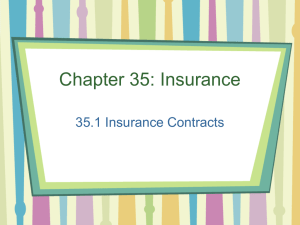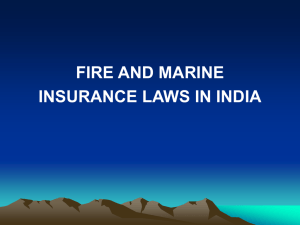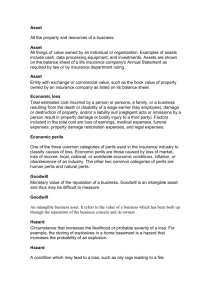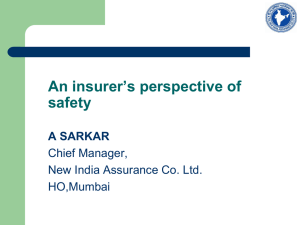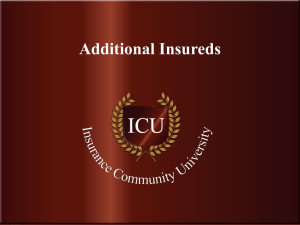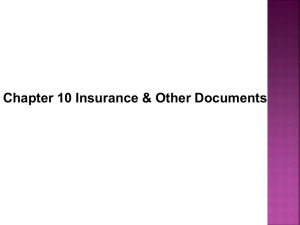Chapter 9 Basic Property and Liability Insurance
advertisement
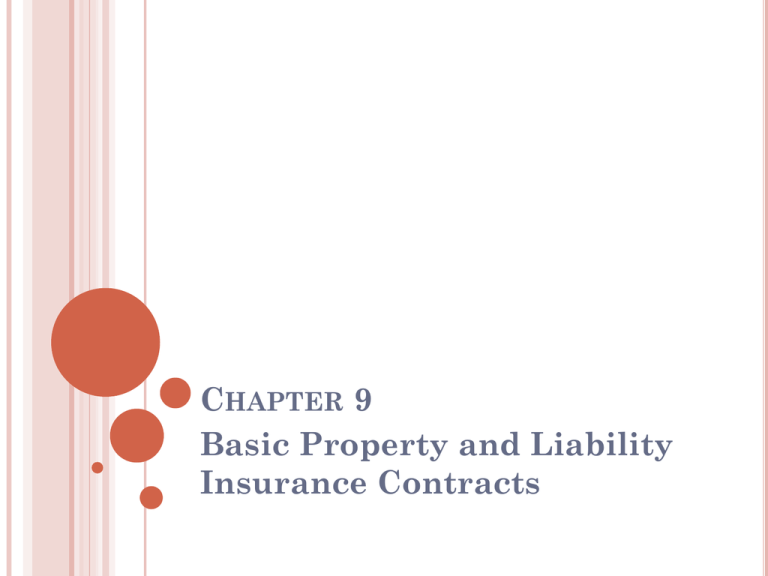
CHAPTER 9 Basic Property and Liability Insurance Contracts SCOPE OF CHAPTER First purpose of this chapter is to make reading insurance policies more meaningful To demonstrate technical English in action To integrate many readers covered in a business law course with the study of insurance To help students think logically and constructively about problem solving. Figure 9-1 Building Blocks of Insurance Policy Insured has to read the policy at the time of issuing not just be concerned about collecting payment from insurer. Is the property covered? Is the person covered? Is the loss caused by a covered peril? Do any deductibles or exclusions apply to the loss? Do policy conditions limit the amount of coverage ? Is the location of the loss covered? Did the loss occur during a covered time period? Figure 9-2 Can I collect on my claim ? BASIC PARTS OF INSURANCE POLICY(DICE) Declaration page (D) Insuring Agreement(I) Condition(C) Exclusion(E) BASIC PARTS OF INSURANCE POLICY(DICE) • • Declarations (D) First element of property and liability insurance Presents the important facts about the coverage provided and personalize the coverage to a particular insured. Example: Specification of property covered(which house, which car, which person). Declarations also specify the insurer’s limits of liability , the annual premium, and payments due for shorter ( quarterly, semiannual) periods. Declarations are prepared from information that the insured provided in the insurance application. INSURING AGREEMENT(I) The insuring agreement is the heart of an insurance contract. It summarize the major promises of the insurer. The insurer agrees to do certain things, such as paying losses from covered perils, providing certain services (such as loss-prevention services) or agreeing to defend the insured in a liability lawsuit. If the loss is not excluded, then it is covered. Example: • • In the homeowner policy , personal property is covered for fire, lightening, windstorm, and certain other named perils. Only losses caused by these perils are covered. Flood damage is not covered because flood is not a listed peril. Most of life insurance contracts cover all causes of death whether by accident or by disease. The major exclusions are suicide during the first two years of the contract; certain aviation hazard exclusions, such as military flying, crop dusting, or sports piloting; and in some contracts, death caused by war. DEDUCTIBLES Deductibles: In property insurance insurers call the first dollars of loss amount that the insured has to pay. Straight deductible : If the insurer pays only for the amount of loss in excess of the deductible. Example: If amount of loss is $100,000 and $200 straight deductible, the insured would pay $200 and the insurer would pay the remaining $99,800. Percentage deductible: The insured pays the first percentage of loss whereby the insurer paying the amount in excess of the deductibles. Example: 2 percent deductible on a $200,000 home destroyed by hurricane wind would require the insured to pay $4,000 and the insurer to pay $196,000. Combination of straight deductible and percentage deductible is also applied by insurance companies. PURPOSES OF DEDUCTIBLE PROVISIONS 1- Deductibles reduce the morale hazard because the insured must pay a small part of every loss. 2-Deductibles eliminate the expenses involved in settling small claims. Savings from reduced expenses and payments for small losses are reflected in lower premium. 3- Deductibles cause the policyholder to finance some of the loss. Policyholder has a significant financial contribution to overall loss costs. Some insurers encourage insured to choose larger deductibles and use the savings to lower premium or increase policy limits. EXCLUSIONS(E) Exclusions identify losses not covered. If an insurer denies to pay the claim because the loss is excluded in the policy it is the legal responsibility of insurer to prove that it applied the exclusion correctly otherwise the insured can contest the denial. Property Insurance exclusions serve the following purposes - To eliminate losses arising from catastrophic events(e.g. insurers exclude damage from nuclear radiation). - To eliminate losses associated with the moral or morale hazard(e.g. in HO policy excludes theft committed by an insured). - To eliminate coverage not needed by the typical insured. In these cases, insurers allow those insured to pay an extra charge to remove the exclusion (e.g. the HO policy excludes liability losses arising from business pursuits, but by using the endorsement the policy cover specified business lawsuit( such as baby-sitting). EXAMPLE OF EXCLUSION IN DIFFERENT INSURANCE CONTRACTS • • • There are three major types of exclusions: Excluded perils, excluded losses, and excluded property. The contract may exclude certain perils, or causes of loss (excluded perils).In a homeowners policy, the perils of flood, earth movement, and nuclear radiation or radioactive contamination are specifically excluded. Certain type of losses may be excluded(excluded losses). In the physical damage section of the personal auto policy , loss to a covered auto is specifically excluded if the car is used as a public taxi. The contract may exclude or place limitations on the coverage of certain property(excluded property). For example, in a homeowners policy , certain types of personal property are excluded , such as cars, planes, animals, birds, and fish. ENDORSEMENTS Endorsements modify standard insurance contracts and they add coverage directly or add coverage by deleting the exclusion in the standard policy . Endorsement can eliminate coverage(for a reduction in premium) or exclude an insured (for example, a teenage driver). In order to achieve the variety of coverage goals endorsement can be used. CONDITIONS(C) Conditions provide a framework for the insurance policy , explaining many of the important relationships, rights, and duties of the insurer and insured. Conditions are provisions in the policy that qualify or place limitations on the insurer’s promise to perform. In effect, the conditions section imposes certain duties on the insured. The 165 lines of the1943 New York Standard Fire Insurance Policy (SFP) contain most of the conditions in fire insurance policy and as mandatory foundation of all property insurance forms. Figure 9-3 shows the traditional 165 lines. The first six lines of the 165 lines explain the results of fraud committed by an insured. COMMON POLICY CONDITIONS Notifying the insurer if a loss occurs Protecting the property after a loss Preparing an inventory of damaged personal property Cooperating with the insurer in the event of a liability suit CONDITION(Cont.) Fraud: Example of insurance fraud Liam insured his house with the ABC Insurance Company. The policy was for $5,000 coverage on the house and $3,000 on the contents. Moral hazard: After the fire destroyed the house, Liam filed a sworn proof of loss that included a claim for a number of nonexistent items. Later, Liam dropped the claim for the contents, but the claim for the dwelling continued. The court denied Liam any recovery because the provisions of the insurance policy as to concealment and fraud are applicable and a sworn proof of loss which includes nonexistent items voids the entire policy. Under the provisions of the current homeowners(HO) the insurer denies the claim if before or after a loss, an “insured” has: 1-Intentionally concealed or misrepresented any material fact or circumstances. 2-Engaged in fraudulent conduct; or 3-Made false statement; relating to this insurance. SUSPENSION OF COVERAGE Some insurance policies specify conditions where the coverage is suspended. The word “while” precedes these conditions, implying that while the specified condition is present, coverage is suspended, but if the condition ends, coverage is reinstated. Condition suspending coverage in the 165 lines include: - Increase in hazard within the knowledge of the insured - Vacant or unoccupied for more than sixty consecutive days. EXAMPLE OF INCREASE IN HAZARD PROVISION Saggy company purchased a fire insurance policy on its warehouse. In fact, the building was not being used as a warehouse but as a mattress factory (keeping the flammable material such as cotton and cotton dust). When the “warehouse” burned, the insurer denied the claim because the hazard was increased within the control or knowledge of the insured. If a case is litigated, the court must decide whether the hazard was increased “substantially”. In this case, the court ruled in favor of the insurer, finding the increase of hazard was “substantial” when the warehouse was used for making mattresses.
